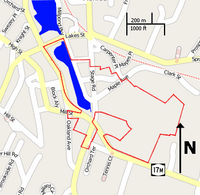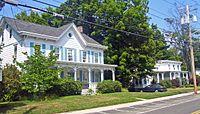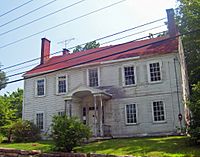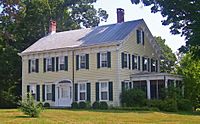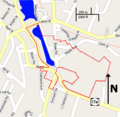Village of Monroe Historic District facts for kids
Quick facts for kids |
|
|
Village of Monroe Historic District
|
|
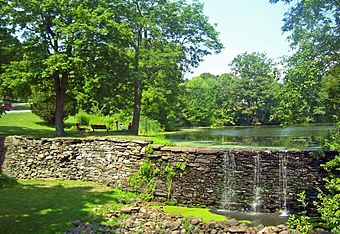
Rebuilt Smith's Mill dam, 2008
|
|
| Location | Monroe, NY |
|---|---|
| Nearest city | Newburgh |
| Area | 81 acres (33 ha) |
| Built | 1760–1940 |
| Architectural style | Gothic Revival, Federal, Greek Revival |
| NRHP reference No. | 98001391 |
| Added to NRHP | 1998 |
The Village of Monroe Historic District is a special area in Monroe, New York. It's also known as the Smith's Mill Historic District. This district covers about 81 acres (33 hectares) and has 36 important buildings. Most of these are homes, but there are also churches and businesses.
This historic area is in the middle of Monroe, just east of the main downtown. In 1998, it was added to the National Register of Historic Places. This means it's a place with important history worth protecting. Much of the district is open space, including a mill pond, a park, a cemetery, and an old racetrack. The buildings here are mostly from the 1800s, but some are even older, from before the American Revolution. These buildings show what Monroe was like when Smith's Mill, the first business, used a dam on Ramapo Creek. Many of these buildings also survived a big fire in 1892 that damaged a lot of the village.
Contents
Exploring Monroe's Historic Geography
The Village of Monroe Historic District has clear boundaries. On its western side, it mostly follows New York State Route 17M. This includes the entire mill pond and park. A small part of the district is west of Route 17M, along streets like Stage, Oakland, Mill, and Ramapo.
On the eastern side, the boundary follows Mill Pond Parkway south from Lake Street. It then goes east along Smithfield Court and south along Stage Road. The boundary then zigzags along property lines to Carpenter Place and Maple Street. From there, it goes south to include the Monroe Cemetery, then returns to Stage Road and Route 17M.
A Look Back: Monroe's History
Early Days: 1700s and 1800s
The village of Monroe started with a man named David Smith. He came from Brookhaven on Long Island. In 1747, he bought a large piece of land, about 276 acres (112 hectares). He had already built a house there in 1741, at what is now Maple and Stage streets. In 1761, he bought more land next to it. These purchases make up much of modern-day Monroe.
David Smith built a dam on the creek to power a mill. Soon, the settlement became known as Smith's Mills. As it grew, it was first called Southfield. Then, in 1808, it was renamed Munroe, after a state senator. Later, people got confused with President James Monroe's name. So, the spelling changed to Monroe, and some stories incorrectly say it was named after the president.
Many of the older homes in the district are built in the Federal style. McGarrah's Tavern, at Stage and Route 17M, is another example. It became a Masonic lodge in 1814. It is still the oldest Masonic building in New York State.
By 1836, Monroe's economy was growing. It had mills and an iron industry. They would melt iron ore from nearby hills. Then they made it into products like nails and anchors. In 1841, the New York and Erie Railroad built its main line near the village. This helped Monroe sell its goods to new places. During this time, the Greek Revival style became popular. The Nicholas Knight House on Stage Road, built in 1811, was later updated in this style. The First Presbyterian Church of Monroe, built in 1853, also shows this style.
The railroads also helped the Monroe Cheese Company. In 1873, they introduced Velveeta cheese, which became famous across the country. Their old factory, built in the Italianate style, is still on Mill Pond Road. Later, the Queen Anne Style became popular. The Methodist Church on Maple Avenue, built in 1841, was renovated in this style in 1885. The Church of the Sacred Heart was built in Queen Anne style in 1896.
In 1892, a big fire destroyed much of the village's downtown area. Two years later, the citizens officially formed the village. This allowed them to create a fire department and a water supply system to prevent future disasters.
Modern Times: 1900s and 2000s
New buildings in the historic part of Monroe slowed down in the early 1900s. The village started to grow in other areas. The racetrack became a popular spot for harness racing from 1908 to 1927. The Colonial Revival style was not as common here. One example is the American Foursquare house at 132 Stage Road, built around 1910.
Since 1940, there hasn't been much new construction in the historic district. The Monroe Theatre, built in 1948, was an exception. It was in the Classical Revival style. The racetrack's grandstand was taken down in 1964. The old stone bridge was demolished in 1994. The Monroe Theater was also demolished and replaced with a new building.
Important Historic Buildings and Sites
The Monroe Historic District has 36 important properties. These include 70 buildings and structures in total. Out of these, 47 buildings and 9 structures, plus four sites, are considered historic. None of them are listed separately on the National Register yet. Some newer buildings, mostly garages, are not considered historic.
- Hophni Smith House, 400 Stage Road. This is a 1.5-story saltbox house built around 1750. It was moved to its current spot in the mid-1800s.
- David Smith-Jeremiah Knight House, 315 Stage Road. This is a 2.5-story Federal style house. Part of it is thought to be the house David Smith built in 1741.
- Smith-Knight Grist Mill, next to the house. You can still see parts of the foundation and other structures like the dam and race from its 1750 construction. The large mill pond is now part of a village park.
- McGarrah's Inn, also known as Goff's Tavern, 300 Stage Road. First built around 1800. The third floor was used by a Masonic lodge from 1814 to 1826. It was expanded in 1839. It was also home to Frederick Hulse, a village mayor and prosecutor in the Nuremberg Trials. Today, it's owned by the Cornerstone Masonic Historical Society and is being restored.
- Monroe Cemetery, north side of NY 17M. This is where early settlers were buried. It was expanded in the 1800s. You can see old Funerary art from both periods.
- Monroe Cheese Company, 30 Mill Pond Road. This is a three-story brick Italianate factory from around 1880.
- Monroe Presbyterian Church, 142 Stage Road. This Greek Revival church was built in 1853. It has fluted columns and a molded frieze. It's one of Monroe's most famous landmarks.
- Monroe Race Track. This is in an undeveloped area south of Stage Road. It was used for harness racing in the early 1900s. The gravel track is still there.
- Monroe Theatre, 34 Mill Pond Parkway. This 1940s masonry Classical Revival theater had four stone pilasters supporting a frieze and pediment.
- Judge William Seaman House, 160 Stage Road. First built as a tavern in 1809. It was moved back from the road and renovated in 1850. Greek Revival and Italianate details were added then. The original porch was removed in the 1930s.
Images for kids




